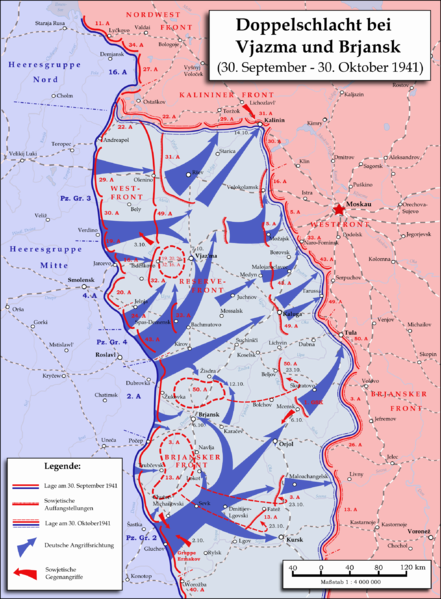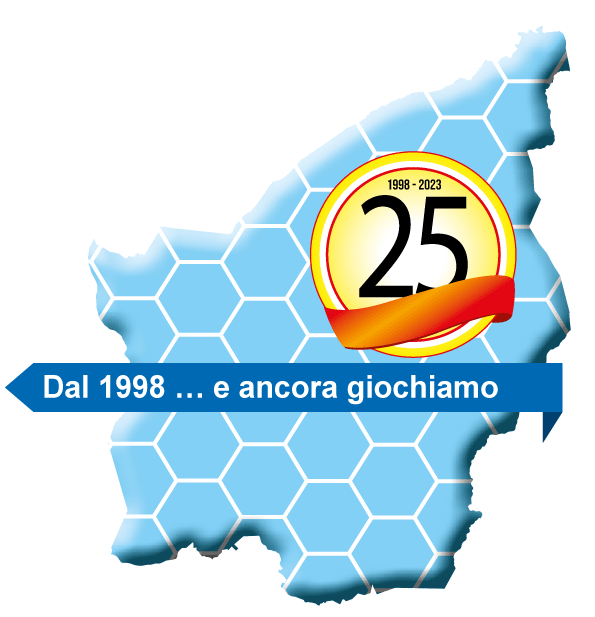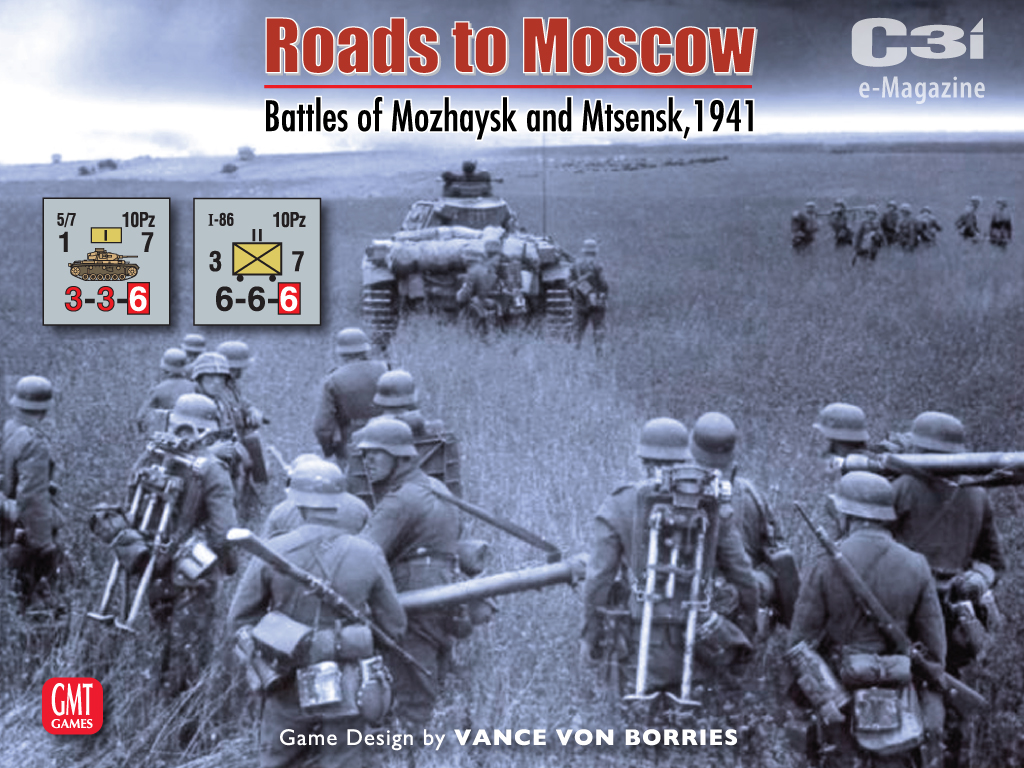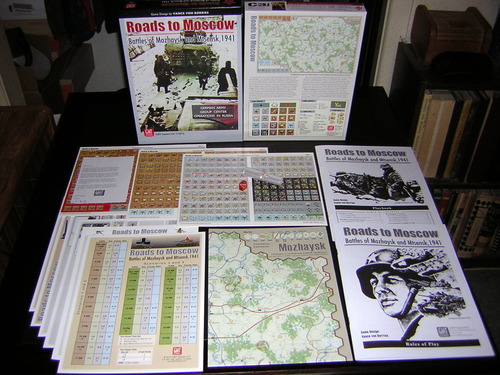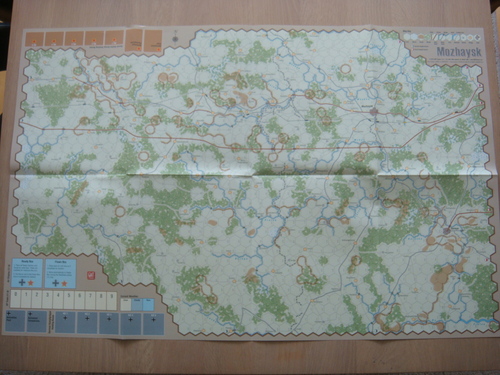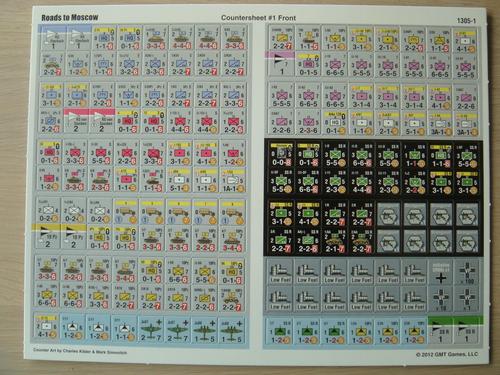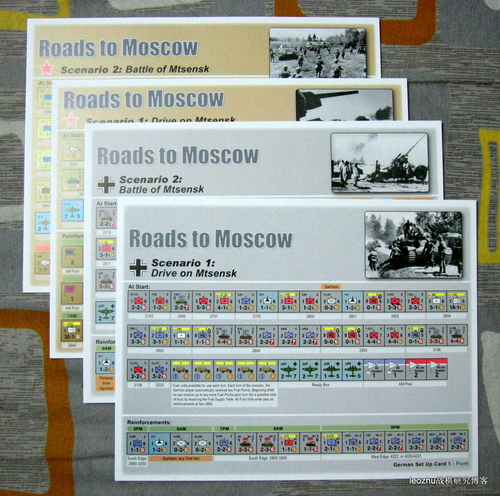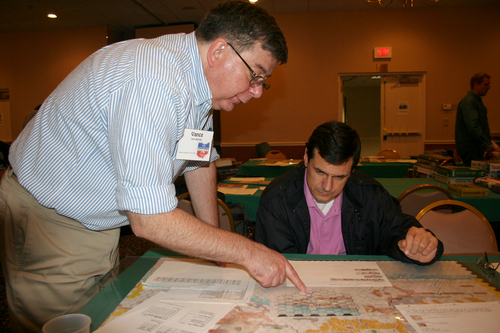|
ROADS TO MOSCOW Battles of Mozhaysk and Mtsensk, 1941 Game Design: Vance Von Borries GMT Games
Introduzione Da Wikipedia: La battaglia di Mosca, combattuta nel periodo tra l’autunno del 1941 e l’inverno del 1942 tra le forze della Germania e dell’Unione Sovietica durante la seconda guerra mondiale, fu una delle battaglie che decisero l’esito dello scontro sul fronte orientale. L’offensiva della Wehrmacht venne dapprima bloccata alle porte di Mosca e successivamente le truppe tedesche furono costrette ad indietreggiare, riuscendo tuttavia ad impedire che la controffensiva dell’Armata Rossa accerchiasse e distruggesse le forze impegnate nell’attacco alla città. La mancata conquista di Mosca precluse la realizzazione del piano strategico dell’Alto comando tedesco, che, nel quadro della stesura dell’operazione Barbarossa, prevedeva la conquista della capitale prima del sopraggiungere dell’inverno e costituì, insieme alla sconfitta nella battaglia d’Inghilterra, il secondo significativo punto di svolta nel conflitto a sfavore dei tedeschi.
From the publisher webpage (GMT Games): Roads to Moscow is a two-player game depicting battles in the Soviet Union during the drive on Moscow in October 1941. The two separate battles shown in this game are named for the main objective city on each map, Mozhaysk to the west of Moscow, and Mtsensk to the south. Perhaps the most dramatic of the many desperate battles fought in front of Moscow, these two battles combined all the elements of the great struggle. The Germans have an excellent fighting machine but are short on fuel and time. They must capture their objectives on a tight schedule or snow and mud will end their offensive. The Soviets are down to the rearward remnants of their once immense armies. If the Soviets can avoid being encircled by the fast moving German forces, high quality reinforcements from the Far East may finally allow them to stop the German advance. Historically, the Soviets stood fast at Mozhaysk, fighting heavily even on the old Napoleonic battlefield of Borodino. Like Napoleon, the Germans eventually took the field, but at great cost in time and manpower. Near Mtsensk Guderian’s Panzer spearhead advancing north from Orel was ambushed by the Soviets thereby disrupting the German timetable. This gave the Soviet 6th Guards Rifle Division time to dig-in on the heights above Mtsensk thereby barring the way to Tula and Moscow. Roads to Moscow uses the same mechanics found in the acclaimed Roads to Leningrad game, featuring a chit draw for activation of formations. Both players quickly learn how to use their motorized units effectively for overruns, combined arms, and movement of reserves. The game includes special rules for Soviet rocket artillery, NKVD, and self-propelled gun units, and fuel supply shortages, and much more, all without overwhelming play of the game. Il sistema di gioco nasce con The battle of Kasserine Road to Leningrad (2009) e un altro titolo, ulteriore evoluzione, è Bataan (2010), edito da Compass Games.
|
|||||||||||||||||||||
|
Contenuto della scatola
Mappa La mappa e’ stampata fronte/retro e presenta una grafica simile al precedente gioco della serie, Road to Leningrad. Bella, chiara, precisa; unico “neo” la dimensione degli esagoni che torna standard, mentre in RtL erano di dimensioni grandi. In questo caso i markers “Force”, che possono sostituire gli stack di pedine in mappa, saranno molto utili! Numerosi i tipi di terreno presenti; in effetti la mappa sembra una classica cartina stradale con sovraimpressa la griglia esagonale. A questo proposito è interessante la nota dell’autore nel playbook a proposito delle piccole città definite “hamlets” le quali, nella scala di gioco presentata, sarebbero in realtà presenti in ogni esagono!! Una nota di “colore”: sulla mappa dedicata a Mozhaysk è possibile individuare due villaggi teatro di famose (o meno) battaglie del periodo napoleonico, Borodino e Maloyaroslavets!!
Pedine/counters Molto belle, chiare e complete le pedine del gioco, di dimensioni “grandi”. Esse riportano valori quali valore di stacking, formazione, designazione dell’unità, efficienza, capacità di movimento e con la raffigurazione classica del tipo di unità (fanterie, corazzati, ecc.). Utilissimi i colori che contraddistinguono ogni specifica formazione.
Regolamento Le regole sono veramente ben scritte; sono praticamente le stesse di RtL con alcune errata incorporate e alcune regole che hanno subito un “up-grade”. Diversi gli esempi grafici e utilissime le Note, che chiariscono la meccanica o l’origine de specifiche regole. Fra le caratteristiche del “sistema”: – un pò macchinosi i calcoli necessari per i combattimenti che devono tenere conto di terreno, efficienza unità, tipo di attacco, aerei, artiglierie, ecc. – ottimo, secondo me, il sistema di attivazione con i “chit” che ricrea l’incertezza e la fluidità delle operazioni belliche. – sempre da valutare la velocità contro il supporto logistico, la concentrazione di forze verso la possibilità di coordinare le stesse, e l’utilizzo delle forze corazzate oltre a quelle di supporto. – alcune interessanti “cromature” sono quelle dei comandanti storici, dei convogli rifornimento per i tedeschi e delle unità di artiglieria con razzi sovietici (queste ultime devono ritirarsi dopo un attacco per impedire di cadere in mani nemiche e rendere possibile ai tedeschi copiarne la tecnologia!!!). In ogni caso anche se il regolamento può sembrare “tosto”, in realtà la complessità non è elevata. Playbook/scenari Ottimo anche il playbook. Gli scenari previsti sono 4, due per la mappa di Mtsensk e due per la mappa di Mhozaysk. Lo scenario 1 è in pratica il “campagna” per quanto riguarda Mtsensk; 15 turni, dai primi combattimenti del 5 Ottobre fino allo scontro finale del 11; lo scenario 2 invece tratta in cinque turni solo dell’ultimo periodo, dal 9 al 11 ottobre. Lo scenario 3 utilizza solo una parte della mappa Mozhaysk e dura solo tre turni; probabilmente sarà un classico “scenario da torneo”; infine, lo scenario 4 permette di ricreare in 15 turni tutta la battaglia per tale città. Interessanti le note del disegnatore e dello sviluppatore oltre alla bibliografia allegata.
Tabelle di gioco Le tabelle fornite sono due, a colori e completissime in merito alle informazioni, che riguardano: Punti Vittoria, tabelle di attacco in versione Assalto e Mobilità, effetti del terreno. Una nota sulle tabelle di attacco Assault e Mobile; in pratica la Mobile presenta risultati più sanguinosi per il difensore mentre quella Assault per l’attaccante. I valori più bassi di tito D10 sono a favore dell’attaccante ma sono inseriti, in diverse colonne, anche risultati bassi ma a favore del difensore. Visto che si utilizza un semplice D10 questo effetto “random” dovrà essere tenuto in considerazione dai giocatori. Prime partite Ho provato in solitario il primo scenario, “Drive in Mtsensk“. Le unità russe sono dislocate lungo la main road che porta alla città di Mtsensk, con le avanguardie dislocate a una decina di esagoni da Orel. I tedeschi sono praticamente attestati attorno a quest’ultima città che è praticamente anche la loro principale fonte di rifornimento. Le città che originano punti vittoria sono sparse nella mappa con le più “ricche” verso Mtsensk, appunto. In un primo tempo il russo ha a disposizione unità deboli, ma poi i rinforzi permetteranno, probabilmente, di creare una solida linea difensiva. Il tedesco ha “fretta”, quindi………. Le unità’ tedesche sono di qualità’ superiore a quelle russe, vuoi per i valori di combattimento, vuoi per il tipo (corazzati), vuoi, soprattutto, per i segnali i di attivazione che, nel caso dei tedeschi, sono quasi sempre 2 per unità’ in gioco. Al contrario le unità’ russe sono più’ numerose ma dispongono quasi sempre di una sola attivazione. in pratica la situazione classica di qualità’ contro quantità’. Attenzione alle regole 7.13 e 7.14 che corrono il rischio di essere “dimenticate” mentre sono importanti! Il cuore del sistema e’ nella pesca dei chit di attivazione; in pratica ogni specifica formazione (divisione, brigata o kamgruppe) dispone di 1/3 segnalini che, quando pescati, permettono l’attivazione di tutte le unità’ che appartengono a quella formazione. Unità cosidette di Armata, in pratica artiglierie, possono essere attivate con le altre formazioni ma per un massimo di 2 volte/turno. La azioni possibili, dopo la pesca del chit, sono: un attacco mobile (più mobilità, meno efficenza nell’attacco), attacco di assalto (maggiore potenza d’urto, meno mobilità), passare. Il “passare” permette poi di poter attivare due formazioni insieme, ammesso di riuscire a coordinarle. La pesca dei chit per attivare le unità può apparire un pò troppo “random” ai puristi del wargame ma in realtà il sistema permette, in maniera semplice ed elegante, di creare una situazione di incertezza e fluidità tipica dei campi di battaglia. Nota Bene: tutte le formazioni/unità muoveranno ad ogni turno e sarà solamente la “sequenza” che verrà stabilita dai chit. Parola d’ordine del sistema e’ mobilità’; la differenza nei risultati di combattimento e’ legata a questo e l’utilizzo delle varie unità’ e’ legata quindi al suo fattore movimento, alla sua attivazione e alla conoscenza dei numerosi tipi di terreno. Come anticipato con la nota sopra a proposito delle Tabelle di combattimento, si utilizzerà sempre, quando possibile, la tabella Mobile, mentre quella Assault dovrà essere usata se obbligatorio (vedi casi specifici evidenziati dal regolamento, es: attacchi a strong point). Importante, poi, è tenere presente che utilizzando la tabella Assault sarà possibile anche attivare 2 formazioni invece che una sola come da pesca del chit. Come in RtL, il giocatore tedesco dovrà esguire azioni rapide e decisive mentre il russo dovrà organizzare attacchi per ritardare l’avanzata tedesca e portare in campo i necessari rinforzi. Il sistema di VvB permtte di ricreare, quindi, la capacità militare tedesca nell’assegnare anche a piccole unità la completa autonomia sul campo di battaglia. Sulla mobilità incide anche il fattore rifornimenti che per il giocatore tedesco assume ulteriore importanza per la regola 6.4 “Fuel Supply”; in pratica ogni turno vede assegnare alle unità tedesche segnalini Fuel che permettono di agire a piena forza. Una sorta di ulteriore fonte di rifornimento da rispettare! Conclusioni – Punteggio
Links interessanti: http://www.wargalley.com/efs/index.php, sulla serie East Front Road to Moscow sarà un must per ogni appassionato del fronte russo; consigliato!
|
|||||||||||||||||||||
|
27/08/2013: Intervista con l’autore Vance con Borries, un autore che si è specializzato su titoli ambientati in nord Africa e il fronte russo. Borries ha ricevuto vari riconoscimenti nel settore boardwargames, fra i quali: 1991 Charles S. Roberts Hall of Fame Nominee 1995 James F. Dunnigan Award for Playability & Design Nominee 1998 Charles S. Roberts Hall of Fame Inductee
(Vance von Borries durante una convention in USA) Vance von Borries ha accettato con mia grande soddisfazione di rispondere ad alcune domande. L’autore ha nel suo carniere diversi titoli interessanti ed ho approfittato, quindi, per rivolgere anche domande generali sull’hobby! GC: Vance Hello and welcome to our website! Thank you for agreeing to publish this short interview. VVB: Thank you for your interest. I enjoy hearing from others in the hobby. It helps me keep in touch with how my games are doing and what other subjects would be desirable. GC: How long if fond of historical simulation? How did you start with and what game? What are your favorite wargames? And what is your profession work? VVB: When I am not designing games, I work in accounting and finance. My professional career has stretched over many years with tax accounting (currently) and formerly in banking and financial analysis. Much time also goes into house restoration (my home is an old house that still needs a lot of work) and gardening. I am nearing retirement, so maybe soon I will have more time for game design. My gaming and even my designing both began while in school. My first work was for my own use and was on improvements to Avalon Hill’s Afrika Korps. This was well before I began any regular job, so it has all stretched over even more years, and there I see no retirement. I enjoy my design work and its challenges and will likely continue with it as long as I can roll dice. I began regular wargaming, as we know it, with the Avalon Hill classics and I am fond of these games because of their simplicity and generally quick pace of game play. Although some may not have been seen as so quick in their day, but they all were entertaining. I find it difficult to pick just one game as a favorite as I have seen a great many over the years. For several years I really enjoyed A House Divided; today it is a real classic, but times have moved on. Our hobby has had a lot to say, and its many games have had a lot of different things to say. Among the more interesting is how my involvement in the hobby has changed the way I read history. As I read certain histories I can see how gaming has helped me see the choices the commanders had. There was also the time when I would draw parallels of how military decision making was similar to business decision making. Leadership in both is closely related. Yes, I have an advanced business degree from my university, so maybe I can’t avoid this viewpoint. GC: Vance, you have published many titles and all interesting, from the mythical Crete, the Avalon Hill, the series Barbarossa, Kasserine and now the series “road” all published by GMT. The Russian front it seems, in any case, your favorite, there is a particular reason? VVB: For the Russian Front I have a good researcher. Without him I may not have built Russian Front games that look like what I have done. He provides much that is critical for each game. This is so vital for it relieves me of a great quantity of time spent in the collection of the basic information necessary to build a game on a historical subject. And, such in-depth information lends credibility to the design. I’ll give you an example later in this interview. It also helps to have an interest in Russian Front campaigns and battles, much like my interest in various Mediterranean campaigns and battles. Every once in a while I may develop an interest also in some other campaign or time in history. You can see this in a few other games I have built, such as Remember the Maine. With these I become responsible for all the research. With these it became necessary that I would do all basic research in order to focus the game on the critical aspects of the campaign while adding elements of color. GC: What, among the titles published in recent years, have been most successful in terms of sales? VVB: The most successful was the Avalon Hill Crete game. Tens of thousands were sold. It brought people into the wargaming hobby. I still receive testimony from gamers to that fact. Today all games have much more limited print-runs, not nearly so many copies are available and there are few locations carry games now. The dynamic changed. Of today’s games perhaps Invasion: Sicily has received more exposure. Sadly, that game is long out of print but there is a considerable call for reprints of the games in my Barbarossa EFS series. I am currently in the process of rewriting the rules to be simpler and easier to understand and to clarify various rules issues. I have a team of players assembled to go through things. We also hope to improve certain other rules, to improve the order of battle research, and make the maps better. This is a lot to do but I want this series to be as successful as possible. GC: The “Road Series” is really very interesting, small battles, operational scale, topics not well known, a lot of interaction between the players. You already have other plans for the series? I think a very interesting titles such as “Road to Stalingrad”, “Road to Berlin” ……….Me and a few members live in San Marino, close to the city of Rimini. In 1944 in the area were some of the most important battles fought on the Italian front, along what was called “Gothic Line”. The “Road” would be very suitable to recreate these battles, I guess a “Road to San Marino” ……..What do you think?? VVB: Yes, I have plans for more “Roads” games. I am capable of building many more. I want to do more “Roads” games. Originally, these were to be games that would compliment campaign games, primarily those of the EFS series. In building those games I might collect so much information on certain battles that I could build a smaller scale game. These would then be battle games that would focus on important aspects of the campaign. This has worked for Leningrad and Moscow, but, obviously, I digressed with Bataan. Bataan is very complete and is the best game you will find on its subject; so there I maintained the system standards. I would agree with you that part of the Gothic Line would be a good choice. I have a larger game in preparation for the whole Italian campaign, so a Gothic Line battle should fit the formula. There are some other battles in Italy that could also fit. Unfortunately, that campaign game is sitting on the shelf. It has to wait for the right time to return it to the design table. The same is also true for other battles and campaigns. I am only one person and have only a limited amount of time. Maybe your friends could figure a way for me to squeeze 48 hours into 24 hours. GC: I noticed that the tables of combat, and Mobile Assault, present the results in favor of the defending player to pull low and favorable to the attacker throws high. You have, however, also included contrary results in several columns. Ex: Assault, 5:1, D10 with results equal to 3, A1/D3R. There is a reason for this effect “random”? VVB: This all depends on what you seek for that particular battle. In a general sense, I have placed the more favorable reults at the top of the chart because this is where you begin to read combat results. Variations occur because each combat odds column should be unique; otherwise, we would just apply a great many die roll modifiers and dispense with odds columns. Keep in mind that with this particular result the rules say that if the defender cannot take all of his losses then the attacker reduces his loss. GC: In your notes you say that some more detailed rules on air strikes have been studied and later deleted. I must admit that I would have preferred that these rules were present. The scale of the game operational / tactical is indicated, in my opinion. Why not think of at least optional rules? VVB: I believe you mean to say, why not bombardment, from both air and artillery. It turns out that the next game in the “Roads” series will have rules on this. Perhaps this is the place to describe the next “Roads” system game. This will be Invasion: Malta. It covers the invasion that almost happened in 1942. It includes scenarios for 1940 where the Italians would have tried to invade without German help and 1941 where the Germans would attack Malta and not Crete. It also will include Leros in November 1943, a historcal battle and one where many of the British defenders had formerly been part of the Malta garrison. You might say that this battle shows what would have happened had the Germans and Italians attacked Malta in earlier years. Of course, the Italians participated in the Leros battle too. Obvously, this is not a game full of tanks. I certainly would have picked another panzer game to be next, but a friend approached me with so much good information that I could not turn it down. This game is an example of what a designer can do when he gets such generous support. As a result I have such an immense volume of historical data that I can tell you incredible details, like precisely where each invasion boat was scheduled to land (in 1942). I did not have this level of information when I built the Avalon Hill game. To do this right, I am stepping down in scale to company level because this is how the battle would have been fought. At this level I need the added rules for artillery and air bombardment that you mention above that was omitted from earlier games. Malta was an artillery battle; the other games were panzer battles. To make the Malta battles interesting the game focuses on the creation of the beachhead during the first 3-5 days. I will not put the gamer through a month of campaigning on these little islands. They would play just the first few turns anyway and this appraoch still leaves an interesting invasion game (in every scenario) of multiple beaches and parachute landing sites. That is a lot of game variation right there. I hope everyone will agree when they see it. GC: My experience as a player and collector of boardwargames in Italy for over 30 years allows me to say that today, at least in Italy, the historical simulation is a hobby niche. A few thousand players who probably love to titles such as RTM and the like. Almost non-existent Italian companies that publish titles in the genre. Luckily in USA companies like GMT, MMP, CG and a few others continue to produce titles every year. In fact in Italy is much more widespread the boardgame, simpler, less historic. What is the situation in the USA, from your point of view? VVB: I agree with your “niche” comment. Unfortunately, the niche aspect has become far more obvious in the past 12 years or so, possibly due to the decline in education standards and an increase in how each individual’s time is programmed. Very little history is taught in American schools today and you have to go looking for it in higher education. Non-military games certainly attract large numbers of the gaming public. I am not as sure about the degree this is true about the rest of the world. Computer games have also played their part and here is the great irony. While the computers take away many potential board gamers, they have saved the hobby. They allow the rest of us to communicate and have given us the most wonderful tools for creating new games. The rise of the simpler games may, in part, be due to the active gaming demographic becoming older. They may still want the games that have depth and substance, but seem to want to break up the decision cycle in each game to make each step shorter and more direct. We certainly are lucky to have GMT, and the others you mention. And, I was lucky to get with the GMT team from its early days. GC: So maybe you are thinking, what future games? VVB: As I mentioned, I have an Italy campaign game to finish. Along with it would be a rebuilt Invasion: Sicily and a Tunisia campaign game. I have done a lot on both of these already. For EFS I will build a Stalingrad campaign and likely will build Army Group A as a separate campaign game. I am less certain about Roads games but they will include a Roads to Stalingrad and something in Libya/Egypt. Other subjects are on my list but the above will keep me busy for a long time. GC: Ok, Vance, thanks for your cooperation and good luck for the next titles that you plan. I take this opportunity to invite you to our annual convention, the SMGC 2014 to be held in May next year. For us it would be an honor to have you as an author who presents and play with us! VVB: I thank you for the opportunity to talk about my games. It is an honor to me to be featured in your letter. I am not sure about attending the convention but maybe one year soon.
|
|||||||||||||||||||||
| GMT Games, € 50,00 |
Settembre 2013: Roads to Moscow
